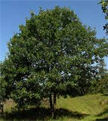 The California black oak is a tree that occurs with some degree of frequency in the San Bernardino Mountains.
The California black oak is a tree that occurs with some degree of frequency in the San Bernardino Mountains.
The black oak, also known as the Kellogg oak, is an oak in the red oak section (Quercus sect. Lobatae), native to western North America and listed under the scientific name Quercus kelloggii. It is a close relative of the black oak (Quercus velutina) found in eastern and central North America.
A deciduous tree growing in mixed evergreen forests, oak woodlands, and Coniferous forests, the California black oak is distributed along foothills and lower mountains of California and western Oregon, from Lane County, Oregon, south through the Cascade Range, the Sierra Nevada, and the Coast, Transverse, and Peninsular ranges to San Diego County, California and into Baja California. The tree occurs in pure or mixed stands. Pure stands usually indicate sites unfavorable to conifer growth or recurring disturbance such as fire or logging activities. The tree can grow in many types of well-drained soils.
The California black oak typically grows from 30 to 82 feet in height and from one foot to four-and-one-half feet in diameter. Large trees may exceed 120 feet in height and five feet in diameter. The species also grows in shrubby scrub-oak form on poor sites. In open areas the crown is broad and rounded, with lower branches nearly touching the ground or forming a browse line. In closed stands, the crown is narrow and slender in young trees and irregularly broad in old trees. Trunks are usually free of branches on the lower 20 to 40 feet in closed stands. Trunks are often forked, and usually decayed and hollow in older trees. The bark is thin and smooth in young trees, becoming thick, ridged, and plate-like with age. A tree grows from one to several vertical roots which penetrate to bedrock, with large, laterally spreading roots extending off from vertical ones. It also has a number of surface roots.
The black oak’s acorns are relatively large, from one inch to 1.2 inches long and six-tenths to seven-tenths of an inch wide. The deeply lobed leaves are typically 4 to 8 inches long. While individual trees generally have a lifespan between 100 and 200 years, California black oak can live up to 500.
The tree reproduces when its acorns sprout to form seedlings. It also reproduces vegetatively with new growth sprouting from the root crown after the tree is top-killed by wildfire, logging, frost, or other events.
A critical species for wildlife, Quercus kelloggii is among the most important genera used by wildlife for food and cover in California forests and rangelands, and the California black oak occupies more total area in California than any other hardwood species. Cavities in the trees provide den or nest sites for owls, various woodpeckers, tree squirrels, and American black bears. Trees provide valuable shade for livestock and wildlife during the hot summer months. California black oak forest types are heavily used for spring, summer, and fall cover by black bear.
It is browsed by mule deer and livestock. Acorns are heavily utilized by livestock, mule deer, feral pigs, rodents, mountain quail, Steller’s jay, and woodpeckers. Acorns constitute an average approaching fifty percent of the fall and winter diets of western gray squirrel and black-tailed deer during good mast years. Fawn survival rates increase or decrease with the size of the acorn crop.
It is a preferred foraging substrate for many birds. Acorn woodpecker, Bullock’s oriole, and Nashville warbler show strong preference for California black oak. The parasitic plant Pacific mistletoe (Phoradendron villosum), which commonly grows on this oak, produces berries which attract birds as well.
Many animals cache the acorns, and acorns that have been stored in the ground or otherwise buried are more likely to sprout than those that remain on the surface.
The tree is adapted to wildfire. It is protected from smaller fires by its thick bark. If it is top-killed and burned away in a larger fire, it easily resprouts and has a good supply of nutrients and water stored in its root system. Acorns sprout into seedlings after fire and sites that have been cleared of canopy and leaf litter in fires are ideal for seedling success.
The black oak is vulnerable to sudden oak death.
California Native Americans preferred California black oak acorns over those of other species for making acorn meal. This acorn was a staple food for many Native American groups. Native Americans recognized the importance of fire to this oak, and purposely lit fires in oak woodlands to promote its health and ensure their food source.
The wood is used for making furniture, pallets, and construction timber. It is used as an ornamental tree.
California black oak comprises a total volume of 29 percent of California’s hardwood timber resources, and is the major hardwood sawn into lumber there.
SBCSentinel
News of note from around the largest county in the lower 48 states.
